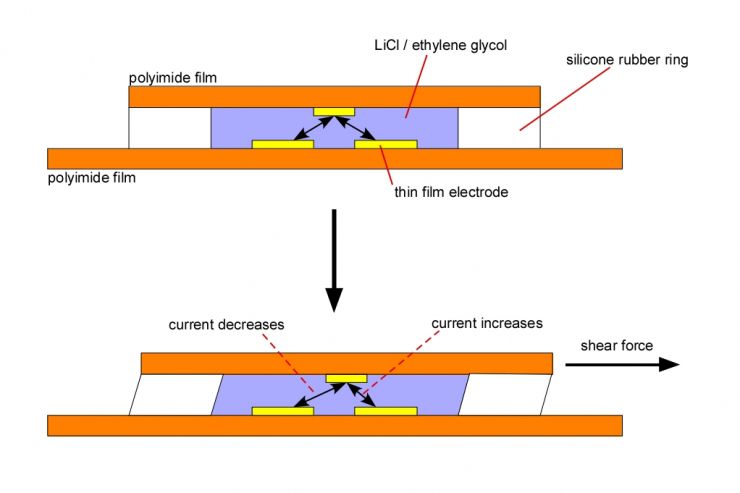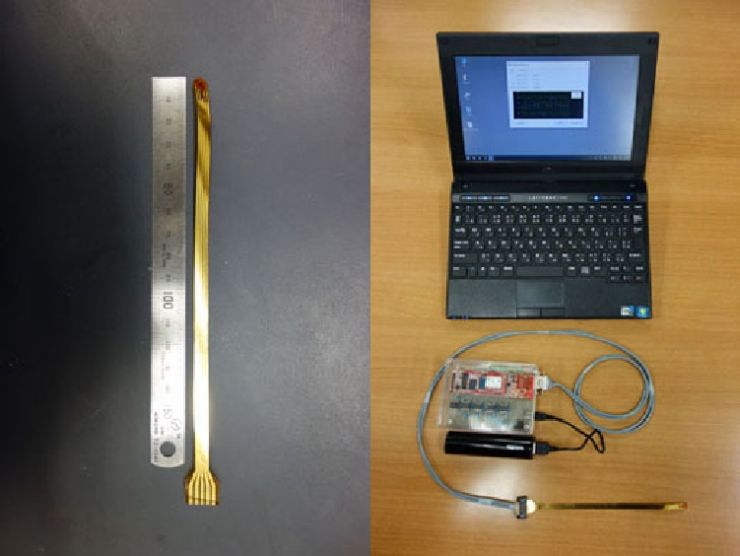Note:For application researches, we are doing with the cooperation of the department of prosthetics and orthotics and the department of assistive technology in the same research institute of the rehabilitation center.
Purpose
We are developing a thin and small sheet type shear force sensor that can be inserted inside the prosthesis socket and the seat of the wheelchair.
Achievement so far
The sensor device itself is newly developed in the laboratory and operates based on its own principle and structure using liquid electrolyte (Fig. 1). So far, we have developed a sensor with 0.7 mm thickness (the smallest diameter of the head is 6.5 mm). We have also developed a portable measuring system to drive the sensor and capture data on the PC (Fig. 2). Furthermore, with its own compensation method, it has succeeded in suppressing temperature fluctuation without incorporating a temperature sensor, and it is almost not affected by pressure. Since it is possible to extend the flat cable from the sensor head to the connector for a long distance, it is easy to incorporate the sensor on the inside surface of the prosthetic foot.
Sensors and measurement devices have already been distributed to multiple collaborators, and applied research results are emerging.
We are also developing a torque sensor with the center of it as an axis as a derived type sensor.

Figure 1. Operating principle of shear force sensor.

Figure 2. Photographs of shear force sensor (right) and measurement system.
Original papers
- S. Shirogane, S. Toyama, M. Hoshino, A. Takashima, T. Tanaka, Quantitative Measurement of the Pressure and Shear Stress Acting on the Body of a Wheelchair User Using a Wearable Sheet-Type Sensor: A Preliminary Study, International Journal of Environmental Research and Public Health, 19, 13579 (2022).
- K. Watanabe, K. Hara, S. Toyama, Development of Hybrid Three-axis Load Sensor, Sensors and Materials, 32(2), 779-790 (2020).
- S. Shirogane, S. Toyama, A. Takashima, T. Tanaka, The relationship between torso inclination and the shearing force of the buttocks while seated in a wheelchair: Preliminary research in non-disabled individuals, Assistive Technology, 32(6), 1949-3614 (2020).
- K. Watanabe, K. Hara, S. Toyama, Novel Sheet-Type Torque Sensor Using Electrolyte, Conference Paper of 2019 IEEE SENSORS.
- T. Nakamura, K. Nakamura, H. Imai, S. Toyama, Measurement of Shear Stresses on a Residual Limb in a Prosthetic Socket, ISPO 17th World Congress, Abstract Book, p. 390 (2019).
- S. Toyama, S. Shirogane, T. Nakamura, K. Watanabe, K. Hara, Development of Thin Shear force Sensor Aimed at Improving QOL for Persons with Disabilities, Eurosensors 2018, Proceedings, 2(13), 704 (2018).
- S. Toyama, Y. Tanaka, S. Shirogane, T. Nakamura, T. Umino, R. Uehara, T. Okamoto, H. Igarashi, Development of Wearable Sheet-Type Shear Force Sensor and Measurement System that is Insusceptible to Temperature and Pressure, Sensors, 17(8), 1752 (2017).
- S. Toyama, Y. Tanaka, Y. Ishikawa, K. Hara, Simple Fabrication Method to Produce Flexible Electrode Capable of Soldering, Sensors and Materials, 28(4), 279-288 (2016).
- S. Toyama, S. Utsumi, T. Nakamura, T. Noguchi, Y. Yoshida, A Novel Thin Shear-Stress Sensor Using Electrolyte as a Conductive Element, Sensor Letters, 11, 442 (2013).
